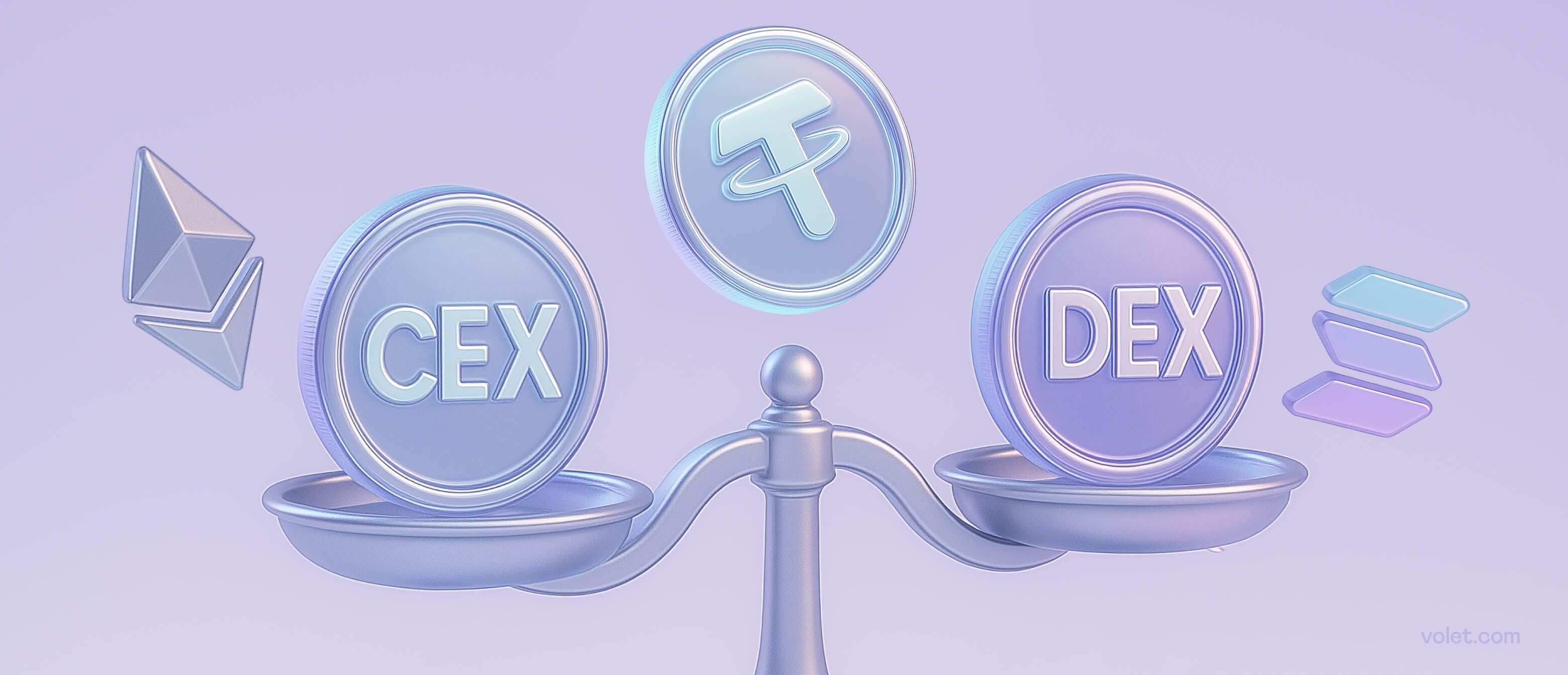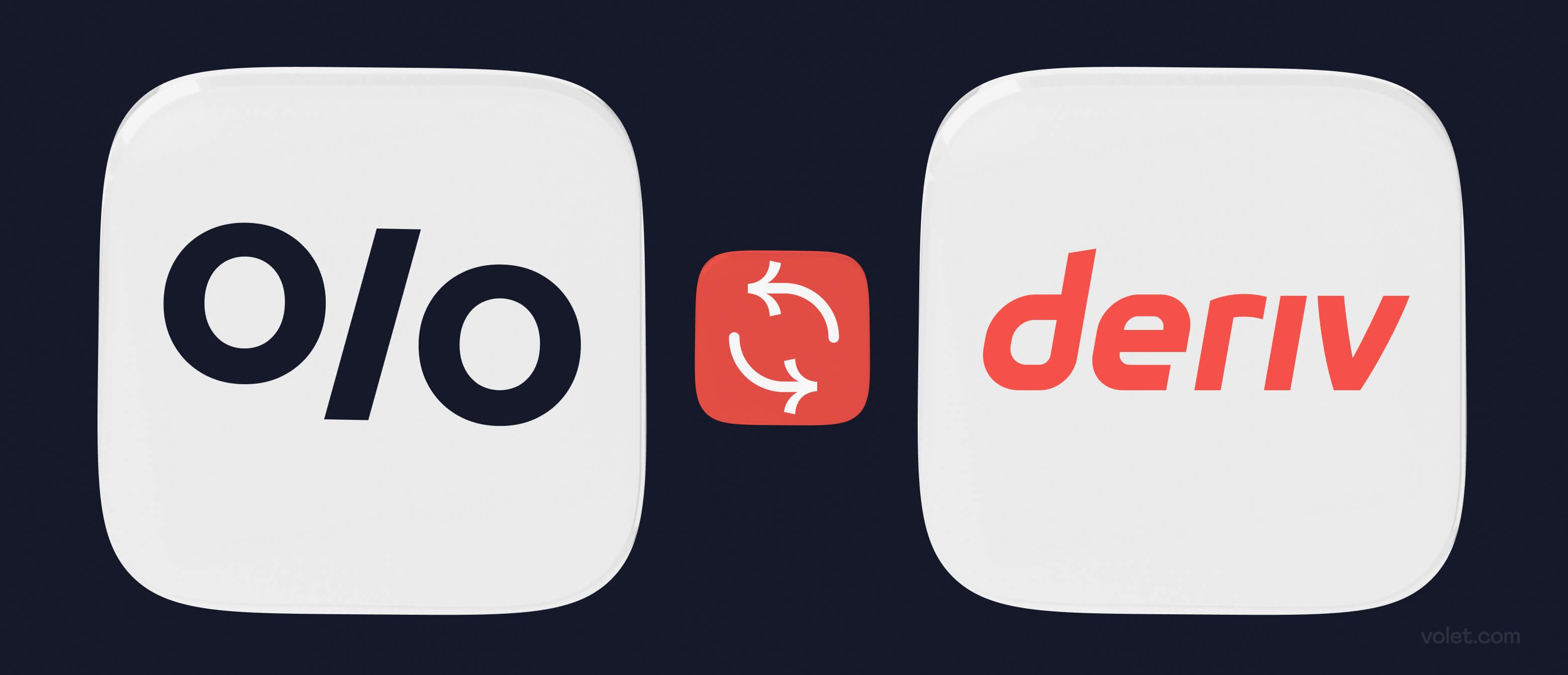 6 min
6 min 212
212How to Convert USDT (TRC20) to USDC on Ethereum or Solana: CEX vs. DEX Routes
Practical Tips for USDT to USDC Swaps

🏦 Swap bigger sums on a CEX (e.g., Binance) — it’s cheaper even if your funds start in a wallet like TronLink.
✅ CEX: Total fee for a $5k swap ≈ $5.5–10.5 | Better rates, but trading UI is slightly more complex.
📉 DEX: Fees for a $5k swap can reach $85+ due to bridging, slippage, and low liquidity. More private and user-friendly, but costly.
🤑Verdict: Use a CEX for lower fees, a DEX for privacy or small amounts.
Let’s say you hold USDT on the TRON network (TRC20) but need USDC on Ethereum or Solana — for payments, investing, or DeFi. You have two main options: swap on a centralized exchange (CEX), or use a decentralized exchange (DEX) or aggregator. This guide compares both approaches, breaking down the fees, speed, and convenience, so you can decide the best route for your situation.
Before we dive into the details, identify your scenario. You’ll likely be in one of two situations:
1. Your USDT is already on a CEX.
The simplest option is to swap USDT for USDC directly on the exchange and then withdraw USDC to your wallet on Solana or Ethereum. Some exchanges also let you withdraw USDT on Solana or Ethereum first, so later you can swap to USDC on a DEX. But this adds extra steps.
2. Your USDT is in an external wallet (e.g., TronLink) on TRC20.
The most reliable method is to deposit USDT to a CEX that supports TRC20, trade it for USDC, and withdraw to Solana or Ethereum. A direct cross-chain swap from your wallet is also possible, but it usually comes with higher fees and lower reliability.
This guide will break down all of these scenarios, starting with the most frequent one, so you can choose the optimal route for yourself.
USDT (TRC20) Already on a CEX
Swap on a CEX and withdraw USDC
If you swap and withdraw $5,000 directly on the same exchange, total costs are almost the same across major platforms, with Binance coming out slightly cheaper overall. Especially on all the networks except for Ethereum.
- Trade USDT/USDC on a spot market
- Withdraw USDC to Ethereum or Solana
- Fees: ~0.1% trading fee + ~$1 withdrawal fee.
Note:
- Initial Amount: $5,000
- Trading Fee (0.1%): ~$5
| CEX | Withdraw Fee | Solana Withdraw Fee | Ethereum Withdraw Fee | Total Cost ($) |
|---|---|---|---|---|
| Bybit | 1 USDC (~$1) | 5 USDC (~$5) | ERC20: $10 | Solana: $6 |
| KuCoin | 1 USDC (~$1) | 5.5 USDC (~$5.5) | ERC20: $10.5 | Solana: $6 |
| Binance | 0.5 USDC (~$0.5) | 1 USDC (~$1) | ERC20: $6 | Solana: $5.5 |
Withdraw to a TRC20 Wallet and Swap on a DEX
If instead of swapping directly on a CEX you withdraw your USDT (TRC20) to a wallet like TronLink, the fee structure changes. You’ll need to account for:
- Withdrawal from the CEX (TRC20 network fee) to TronLink: around 1–1.5 USDT depending on the exchange (Binance ~1 USDT, KuCoin ~1.5 USDT, Bybit ~1.5 USDT).
- Swap fees on a DEX or aggregator (see examples in the table below).
Note:
- Initial Amount: $5,000
- CEX Withdrawal Fees: Binance ≈ 1 USDT, KuCoin ≈ 1.5 USDT, Bybit ≈ 1.5 USDT
| Platform | Route | Swap Fees (USDT→USDC) | Final Amount (USDC, Binance / KuCoin-Bybit) |
|---|---|---|---|
| Rango | Tron → Ethereum | 15.5 USDT | 4,983.5 / 4,983.0 |
| Rango | Tron → Solana | 30.6 USDT | 4,968.4 / 4,967.9 |
| Bungee | Tron → Solana | – | – |
| Bungee | Tron → Ethereum | – | – |
| Symbiosis | Tron → Ethereum | 24.1 USDT | 4,974.9 / 4,974.4 |
| Symbiosis | Tron → Solana | 27.44 USDT | 4,971.56 / 4,971.06 |
| Rubic (Exolix) | Tron → Solana | 87.51 USDT | 4,911.49 / 4,910.99 |
| Rubic (Bridgers) | Tron → Ethereum | 47.4 USDT | 4,951.6 / 4,951.1 |
Which Route Is Cheaper?
When you look at the numbers side by side, the difference is pretty clear.
- Centralized exchanges (CEXs) come out much cheaper if you hold your funds on a CEX. Swapping $5,000 USDT (TRC20) to USDC directly on a CEX and withdrawing costs around $5–6 on Binance or Bybit, and up to $10–10.5 on KuCoin. Binance is the cheapest overall, especially if you withdraw to Solana.
- DEXs and aggregators, on the other hand, are much more expensive if you move money there from a CEX. The cheapest option we’ve tested (Rango from TRON to Ethereum) was $15.5, while most others ranged between $24 and $87.
👉 So if your USDT is already on a CEX, it’s almost always better to swap there and withdraw. Using a DEX or aggregator only makes sense if you need a very specific cross-chain route that a CEX doesn’t support and aim to stay more private — otherwise, you’ll just be paying extra.
USDT (TRC20) Already in a TronLink
Withdraw to a CEX and Trade USDT for USDC
If your USDT is in a private wallet like TronLink, the total cost for converting $5,000 this way is pretty low, generally between $5.50 and $10.50, depending on the CEX and your final destination network. Binance consistently offers the lowest fees, especially for withdrawals to Solana.
- Transfer from TronLink to the CEX (Tron network fee): This is a minimal cost, typically around 0.345 TRX (~$0.07-0.09) to send USDT to your exchange deposit address, regardless of the amount.
- Trading fee on the CEX: A standard 0.1% fee for the USDT/USDC swap.
- Withdrawal fee from the CEX: This varies by exchange and destination network (see table below).
Note:
- Initial Amount: $5,000
- Network Fee (Tron transfer): 0.345 TRX (~$0.08)
- CEX Trading Fee (0.1%): ~$5
| CEX | Withdraw Fee → Solana | Withdraw Fee → Ethereum | Total Cost → Solana ($) | Total Cost → Ethereum ($) |
|---|---|---|---|---|
| Bybit | 1 USDC (~$1.00) | 5 USDC (~$5.00) | -$6.08 | -$10.08 |
| KuCoin | 1 USDC (~$1.00) | 5.5 USDC (~$5.50) | -$6.08 | -$10.58 |
| Binance | 0.5 USDC (~$0.50) | 1 USDC (~$1.00) | -$5.58 | -$6.08 |
USDT/USDC Swap on a DEX
If you hold USDT in TronLink and swap it for USDC directly on a DEX, total costs vary across platforms, with aggregators like Rango offering competitive rates depending on the route. Especially on Solana networks.
- Swap USDT/USDC on a DEX. Fees: ~0.1-0.3% bridge fee + ~$1-5 network gas fee (varies by chain) + potential slippage (0-1%)
- Withdraw USDC to Ethereum or Solana. Fees: Additional ~$0.01-$10 gas fee (depends on network)
Note:
- Initial Amount: 5,000 USDT
- All amounts are in USDC after swap.
- Fees are expressed in USDT → USDC conversion costs.
| Platform | Route | Final Amount (USDC) | Fees (USDT → USDC) |
|---|---|---|---|
| Rango | Tron → Ethereum | 4,984.50 | 15.50 |
| Rango | Tron → Solana | 4,969.40 | 30.60 |
| Bungee | Tron → Solana | – | – |
| Bungee | Tron → Ethereum | – | – |
| Symbiosis | Tron → Ethereum | 4,975.90 | 24.10 |
| Symbiosis | Tron → Solana | 4,972.56 | 27.44 |
| Rubic (Exolix) | Tron → Solana | 4,912.49 | 87.51 |
| Rubic (Bridges) | Tron → Ethereum | 4,952.60 | 47.40 |
Which Route Is Cheaper?
The winner is clear: Using a centralized exchange (CEX) is much cheaper.
Even if your USDT is in your own wallet (like TronLink), sending it to a CEX like Binance, swapping it there, and then withdrawing it is your best bet.
- Using a CEX (like Binance): The whole process will cost you around $5.50 to $10.50 for a $5,000 swap. That means you get to keep almost all of your money.
- Using a DEX (directly from your wallet): This is way more expensive. The cheapest option here will still cost over $15, and some can go as high as $87. You end up with significantly less USDC in the end.
In short: If you want to save on fees, just use a CEX. Only use a DEX if you really don't want to use a centralized exchange at all, or if you're moving a very small amount of money. For $5,000, the choice is simple.
Disclaimer
This article is provided for informational purposes only and does not constitute legal, financial, or professional advice. All content is based on publicly available information and personal opinions. Readers should seek professional guidance before making decisions or acting based on the material presented. The author and publisher assume no liability for any actions taken or not taken by the reader based on the information contained herein.





























